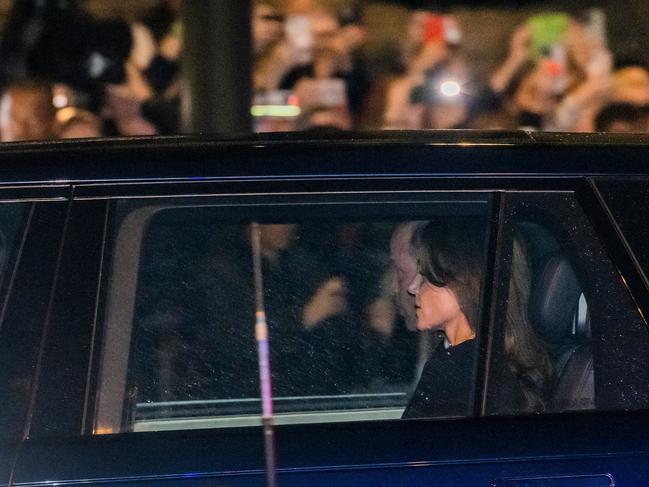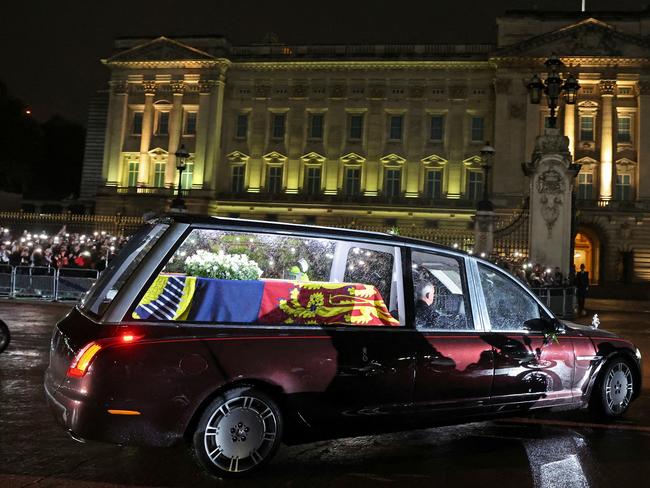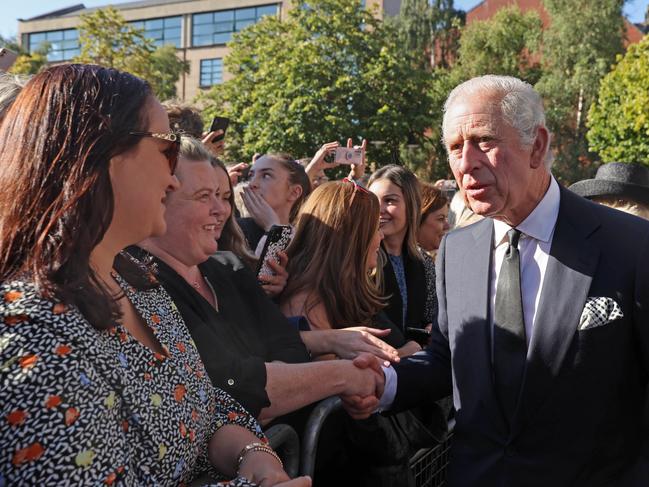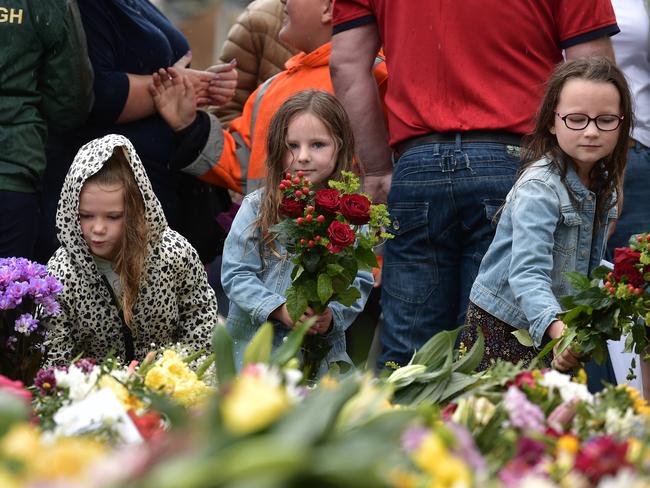Queen funeral: Coffin arrives at Buckingham Palace ahead of procession
A body language expert reveals how the Queen’s grandsons and their wives are struggling to deal with the monarch’s death.

Royals
Don't miss out on the headlines from Royals. Followed categories will be added to My News.
The Queen’s passing is having a profound impact on her grandsons princes William and Harry, and their wives Kate Middleton and Meghan Markle, according to a body language expert.
Looking at photos of the royal couples as they drove through the streets of London, following Her Majesty’s hearse as she returned – for the last time – to Buckingham Palace, the expert said the Queen’s death was “taking a toll”.
Connection Specialist and Body Language Expert, Katia Loisel, said the day’s proceedings appeared to be taking their toll on Prince Harry.


“The expression on Prince Harry’s face here; his open mouth, jaw dropped, eyes wide and brows slightly raised is one of disbelief,” she said.
“While Prince Harry and Meghan’s bodies orientate slightly inward, Meghan’s head titled slightly towards Harry reflects a subconscious need to connect.
“They appear very much in their own thoughts here.”
Prince William and the Princess of Wales’ non-verbal communication reflected the enormity of their loss, Ms Loisel said.
“Prince William looks straight ahead, neck turtled, head slightly lowered, hand clenched downwards in his lap indicating discomfort and a non-verbal need to retreat,” Ms Loisel said.
“His slight frown, tightened lips, and lower lip pushed up slightly a subtle partial expression of sadness.
Partial expressions are often seen when people try to control or suppress their emotions, Ms Loisel explained.
“While looking out towards the public, Kate’s expression is sombre, her torso orientated inward, turned towards Prince William in a non-verbal show of connection and support.”
THOUSANDS GATHER FOR QUEEN’S FINAL JOURNEY
In extraordinary scenes, thousands of Londoners took to the streets to witness the Queen’s coffin driven through central London on her final journey home.
The Queen was received by King Charles III and the entire royal Family including the Queen Consort, the monarch’s feuding sons Princes William and Harry and their wives Kate Middleton and Meghan Markle.
Peak hour traffic came to a standstill as the coffin flew back to the capital from Edinburgh before being driven in a specially designed hearse with clear side windows to allow maximum public display.



The route from RAF Northolt in west London to Buckingham Palace was well promoted and prompted thousands of people to line the curbs to cheer, applause and just witness the spectacle of the cortege weaving through some of central London’s busiest shopping strips and pub quarters to Buckingham Palace.


The new state hearse had been designed by the Royal Household and Jaguar Land Rover with the Queen approving its design plans.




A helicopter overhead beamed the scene live to television.
At the palace, the cortege was greeted by the royal family with that moment declared private time.
The palace did reveal standing at the palace’s inner grand entrance was the new King Charles and his Queen Consort Camilla, surrounded by the late monarch’s children and grandchildren and their partners, including the Prince and Princess of Wales William and Kate and Duke and Duchess of Sussex Harry and Meghan.



‘HUMBLING AND UPLIFTING’: PRINCESS ANNE BREAKS SILENCE
Queen Elizabeth II’s coffin embarked on its journey home to England, escorted by her only daughter Princess Anne.
The coffin left St Giles’ Cathedral in Edinburgh for a flight to London, where it will be displayed ahead of her funeral next week.
The Princess Royal accompanied the casket from Edinburgh on its way to Buckingham Palace.


Anne, 72, arrived just after 4pm local time to escort the Queen’s coffin past streets lined with thousands of mourners catching a glimpse of its final moments in Scotland.
After arriving in England, the Princess Royal paid a heartfelt tribute to her mother, saying it was an “honour and “privilege” to escort her on her final journey from Balmoral to London, never leaving her side.
In an emotional acknowledgment to her mother, the Queen’s only daughter said in her first statement sent since her peaceful death on Thursday, “I was fortunate to share the last 24 hours of my dearest mother’s life”.
“It just been an honour and a privilege to accompany her on her final journeys,” she added.
Anne accompanied the Queen’s cortège on a six-hour road journey from the castle where she died in the Scottish Highlands to Edinburgh.
The next day, she walked in a procession with her siblings behind their mother’s coffin along the city’s Royal Mile.
On Tuesday, she journeyed with the Queen’s body by plane from Edinburgh to Buckingham Palace, saying that “witnessing the love and respect shown by so many on these journeys has been humbling and uplifting”.


Flight tracking website Flightradar24 said “nearly six million people attempted to follow” the flight carrying the Queen’s coffin from Edinburgh to RAF Northolt in London.
The number of people attempting to track the plane caused the website to run into problems, but not before more than half a million were able to briefly follow.
“In the moments before takeoff, nearly six million people attempted to follow the flight, causing disruption to our platform. We are working to ensure stability across our platform at the moment,” a statement on Flightradar24’s Twitter account read.
Another tweet confirmed: “600k able to follow. Six million total attempts (which is what brought the site down).”
Flight KRF01R was the most-tracked flight in the world on Flightradar24 once the website recovered, with over 350,000 watching the Boeing C-17A Globemaster III as it moved south through the UK, having left Edinburgh at 17:42 on Tuesday.
Waiting to receive them at Royal Air Force Northolt, in North West London, will be King Charles and Camilla, Queen Consort, who departed Belfast after an emotional visit.
A guard of honour formed of three officers and 96 soldiers from The King’s Guard will be mounted in the Palace Quadrangle. And the Queen’s coffin will rest in the Bow Room overnight.

IRISH REPUBLICANS HONOUR QUEEN
King Charles gathered together leaders of Sinn Fein - the political wing of the Irish Republican Army - to honour the Queen at a solemn memorial service in Belfast.
Michelle O’Neill, vice president of Sinn Fein, sat alongside pro British Democratic Unionist Party leader Sir Geoffrey Donaldson at St Anne’s Cathedral in the centre of the city.
The remarkable, poignant service, came after King Charles had delivered a speech vowing to continue his late mother’s work to bring peace to Northern Ireland.
British Prime Minister Liz Truss was also in attendance, as thousands lined the streets outside the church.



A heavy, but subtle security presence was in place, with armoured police vehicles with metal grills parked in side streets as a precaution.
King Charles gave a speech at an earlier engagement at Royal Hillsborough, which was ahead of the cathedral service early on Wednesday morning Australian time.
“In the years since she began her long life of public service, my mother saw Northern Ireland pass through momentous and historic changes,” His Majesty said.
“Through all those years, she never ceased to pray for the best of times for this place and for its people, whose stories she knew, whose sorrows our Family had felt, and for whom she had a great affection and regard.

“My mother felt deeply, I know, the significance of the role she herself played in bringing together those whom history had separated, and in extending a hand to make possible the healing of long-held hurts.”
King Charles added he would take up his new duties “resolved to seek the welfare of all the inhabitants of Northern Ireland.”
There was a special nod to the Queen inside the cathedral, with flowers arranged in her racing colours of purple and scarlet.
Scott McCarter, 24, waited for more than four hours to see King Charles.
He said he was deeply upset at the Queen’s passing, but had confidence in her son.
“It is now our duty to get behind our new sovereign,” he said.
“He’s waited 70 years to get on the throne and I’m sure he will be able to conduct himself properly.”

Mr McCarter had travelled 90 minutes from his home in Strabane, near Londonderry, to see King Charles at Royal Hillsborough.
The monarch’s visit comes at a time when Sinn Fein - a party that wants to break away from the United Kingdom has gained power for the first time.
King Charles made a trip to Northern Ireland a key part of the commemorations for the Queen as he attempted to shore up support in the region.
Almost 2 million people live in Northern Ireland, with the country concerned about how Brexit rules will be applied following the UK’s split from the European Union.
More than 3,500 people died in the 30 year conflict known as The Troubles, which ended in 1998 with the Good Friday Peace Agreement.
There were more than 10,000 bombs used in the conflict - almost one a day - for three decades.
EMOTIONAL SCENES IN BELFAST
King Charles has spoken about his late mother’s role in “bringing together those whom history had separated” and “extending a hand to make possible the healing of long-held hurts” in Northern Ireland.
Appearing at Royal Hillsborough Castle as part of his UK tour, the King reiterated that it was “a time of great personal sorrow” following the death of Queen Elizabeth II who died at her Balmoral residence in Scotland on Thursday.
“It is fitting that we should meet at Hillsborough, which my mother knew so well, and in whose beautiful rose garden she always took such pleasure,” he said.
“In the years since she began her long life of public service, my mother saw Northern Ireland pass through momentous and historic changes. Through all those years, she never ceased to pray for the best of times for this place and for its people, whose stories she knew, whose sorrows our Family had felt, and for whom she had a great affection and regard.
“My mother felt deeply, I know, the significance of the role she herself played in bringing together those whom history had separated, and in extending a hand to make possible the healing of long-held hurts.”
The new monarch said the Queen, at the very beginning of her life of service, had “made a pledge to dedicate herself to her country and her people and to maintain the principles of constitutional government”.
“This promise she kept with steadfast faith,” he continued.
“Now, with that shining example before me, and with God’s help, I take up my new duties resolved to seek the welfare of all the inhabitants of Northern Ireland.
“During the years of my mother’s reign, it has been a privilege to bear witness to such a devoted life. May it be granted to us all to fulfil the tasks before us so well.”
King Charles left Royal Hillsborough at 11.30pm Sydney time on Tuesday.
He was being driven to St Anne’s Cathedral in central Belfast for a service at midnight Australian time.



Earlier in the day, crowds cheered as King Charles and his wife Camilla, Queen Consort, arrived at Royal Hillsborough Castle.
A chant of “God Save the King” rang out before some started singing the national anthem.
The couple arrived in a Black BMW, which was escorted by police on motorbikes.
A tight security detail remained around the royal couple at all times, at times slapping away iPads pushed into the King’s face for a photograph, but it was otherwise absolute enthusiasm. Such were the number of hands stuck out to shake the hands of the couple, Camilla at one stage took to doing double handshakes, that is using both her hands to shake simultaneously.
King Charles waved to the crowd before heading into the castle to meet dignitaries.
The emotional crowd had been waiting for hours to welcome King Charles at Hillsborough Castle, outside Belfast, as the new monarch tours every corner of the United Kingdom.
Thousands of people were lined either side of the high st outside the castle, hours before he was due to arrive at 9pm Sydney time on Tuesday.
It came as there was a heavy police presence in Belfast, where the King was due to attend St Anne’s Cathedral at midnight Sydney time.
Police were patrolling the streets armed with metal rods, inspecting for any unusual items, while armoured vans were parked across the city.
Others officers were on top of bridges on the freeway on the road out to Hillsborough Castle, about 20 minutes from Belfast.
HOURS WAIT TO SEE THE KING
Hannah Buchanan, 25, was on the street near the castle three hours early with her children Levi, 2, and Edward, eight months.
“I’ve come with my sister-in-law and the rest of the family, there’s no school today, we’ve given them the day off,” she said.

“Oh my goodness, this is history in the making. We’ve never seen King Charles before. We wanted to pay our respects to the Royal Family and this is so big for the children.
“I remember seeing the Queen in Belfast in 2001.”
Marjorie Stitt, 73, and her husband Eric, 80, gave their grandchildren the day off school to see King Charles at Royal Hillsborough Castle.
“We wanted to show our loyalty to the Queen, we felt it was important for the children to come. Their mammy is a schoolteacher so she didn’t approve but we persuaded her.”

Mr Stitt served in the British Army in Berlin between 1962 and 1966.
“I saw the Berlin Wall being put up,” he said.
He also served in Hong Kong between 1966 and 1968, where his role was to enforce a curfew.
Mr Stitt said King Charles was up to his new job.
“He will do a tremendous job, I think he will do very well indeed,” he said.

CHALLENGES AHEAD
King Charles comes to Northern Ireland just months after Sinn Fein, a party that wants to break away from the United Kingdom, won power for the first time.
The Belfast visit is the most critical and sensitive part of King Charles’s UK tour, and will bring a whirlwind day of mixing protocol, politics and his own personal loss.
He has become king amid an ongoing dispute about how Brexit rules will be enforced. The European Union wants some “invisible” checks on goods coming into Ireland from Northern Ireland but Britain has refused.
All sides of politics want to avoid a hard border between Northern Ireland and the Republic of Ireland.
The split has put pressure on unionists in Northern Ireland, those loyal to the Monarchy, because it is making exporting to Northern Ireland less attractive.
Brexit has also reduced the migrant workforce in Northern Ireland because it is no longer part of the European Union, which allowed people to work anywhere in member countries.
Unemployment in the United Kingdom hit its lowest level since 1974, according to figures announced on Tuesday.
Wages were up more than five per cent, but spikes in inflation meant people were actually worse off.
The Ukraine war has seen energy prices soar in Europe, while France has had to beg neighbours for electricity as its nuclear power industry struggled with maintenance issues.
Quinn’s Bar in Northern Ireland banned for life patrons who had celebrated the Queen’s death last week, while some people in Republican areas in Belfast let off fireworks.
The symbolism in the visit is rich, with King Charles and Queen Consort Camilla due to view an exhibition about his late mother’s deep links to Northern Ireland at Royal Hillsborough Castle, the site where the 1998 Good Friday Peace deal was ironed out, ending decades of violence.
The royal couple have their own connection to the castle, reopening it two years ago after a $33 million renovation.


On Monday, King Charles joined his siblings the Princess Royal, Prince Andrew and the Earl of Wessex in the procession of the Queen’s cortège from Edinburgh’s Palace of Holyroodhouse to St Giles’ Cathedral.
The royal siblings later stood guard over the Queen’s casket at St Giles’s Cathedral, in a solemn 15-minute ceremony known as the Vigil of the Princes.
Princess Anne’s inclusion in the ceremony marked the first time a woman had ever been involved in the event.
Extraordinary crowds turned out for both the procession, and for the opportunity to view the Queen’s casket at St Giles, with reports some people waited 15 hours for just a brief viewing.
Even bigger crowds are expected on Wednesday, when the Queen’s coffin will be transferred to Westminster Hall after a procession and a service led by the Archbishop of Canterbury.
The plane set to carry the Queen’s coffin from Edinburgh to London evacuated thousands of people fleeing the Taliban in Kabul last year.
The “heavily used” C-17 Globemaster has also been used to take humanitarian aid and weapons to Ukraine following Russia’s invasion.
The RAF has been tasked with moving the Queen’s coffin early Wednesday Australian time.
It will be the first of four days when the coffin will lie in state, with estimates that as many as 750,000 people could take the opportunity to pay their respects.

Mourners have already been assembling overnight on the south side of the Thames, across from Westminster Hall, despite official requests not to do so.
All eyes have been on the new sovereign as he transitions to his new role, the one he has spent a lifetime preparing for, all while mourning his mother.
Royal commentators have so far commended the new King for his public utterances, which have managed to uphold royal protocol at the same time as being deeply personal. The assurances he has given about his respect for the conventions of the British political system have also gone some way to allaying fears he would be a meddling monarch.
King Charles and Camilla have also delighted members of the public by stopping to speak and talk on a couple of occasions during the mourning period, the gesture interpreted as a sign of a monarch who is very much in touch with the sentiments of the people.
Royal watchers noted during the procession in Edinburgh that King Charles opted to march shoulder to shoulder with his siblings, rather than out in front, as protocol would have entitled him to do.
‘IT WAS VERY MOVING, VERY BEAUTIFUL’
They queued for more than five hours through the night until dawn.
Thousands of strangers in the Edinburgh darkness united in one solemn aim, to pay a personal respect to Queen.
Some left in tears. Some were joyous at having achieved their once in a lifetime mission. Others went simply because they felt they ought to.
Glaswegian Robert Fyfe, 69, born the same year the late Queen acceded to the throne, joined the queue for the St Giles Cathedral viewing at 5am and entered the cathedral shortly before 10am.
“The Queen has always been a constant figure in most of our lives, and it really hits you when you see the coffin, that she won’t be coming back,“ he said
“She was there on my television at every Christmas with a message.
“Seeing her, with the crown on her coffin, brought it all home, – it makes you think about your own mortality.
“Most of us are saying goodbye to the Queen and to someone we have lost.
“It was a very emotional moment saying goodbye
“If she hadn’t died at Balmoral, the Scottish people wouldn’t of had a chance to say goodbye.
“I’m sure she planned it like this.”
Elaine Thorne, from Lockerbie in south west Scotland, 110kms from Edinburgh, left the 14th century cathedral in tears.
“It was very moving, very beautiful,“ she said.
“She’s lived a life of integrity, dignity and kindness and humility … she’s somebody I can look up to.
“I, personally, shall miss her very much.”
Rens van den Benkel, 27, flew from Holland to Edinburgh when he heard on television the queues had subsided in the morning.
“I told my dad I’m getting on a plane, I’m going to see the Queen, he said I’d be wasting my time- but I got to see her.
“When will you ever get to be part of another Queen dying again?
“She did so much for the people of Britain, and around the world, the least I can do is personally say goodbye,” he said.
Gillian Daniel, 52, and her daughter Ailsa, 10, began the queue joking with strangers but left in reflective silence.
“It was nice, all the flowers and the crown, it was a moment in history, I’ll probably never see another queen on the throne again,” Ailsa said, visibly buoyed by the accomplishment. “But it was very sad as well,” she added.
“It was very moving,” her more sombre Gillian said.
“ I feel sorry for the Royal family, they haven’t been able to grave and Private and it only happened a few days ago, “she said
“We’re also all forgetting the Royal family only lost their dad a few weeks ago, it’s very sad time in their lives.”
PRINCE EDWARD TO GET NEW TITLE
The Queen’s final wish to have her youngest son Prince Edward given the title Duke of Edinburgh is likely to be honoured.
When the Queen’s husband Prince Philip died in April last year it was revealed it was his desire that Edward be given his title of Duke of Edinburgh.
The title was officially inherited by the then Prince Charles as the eldest son when his father died but the Queen had made it clear she wanted it to go to Edward.
The Queen’s former press secretary and royal commentator Dickie Arbiter said it would be hard for the now King Charles III to ignore the Queen’s wish.

“It’s up to the king but he will probably follow his father’s wishes and his mother’s wishes that ultimately it goes to Edward. It’s just exercising a bit of patience. It was Prince Philip’s wish and it was the Queen who endorsed it … it’s up to the king as to when.”
With King Charles’ desire for a slimmed down monarchy it is also a possibility he gives the title to someone higher up in the line of succession (Edward is 13th in line) such as one of his sons.
Edward, currently the earl of Wessex, took over much of his father’s duties related to the international Duke of Edinburgh Awards self improvement youth program developed by Philip in 1956 when Philip fell ill. More than 775,000 young Australians have completed the award since it was established in Australia in 1959.
More Coverage
Originally published as Queen funeral: Coffin arrives at Buckingham Palace ahead of procession




